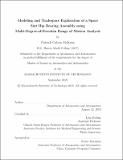| dc.contributor.advisor | Leia Stirling. | en_US |
| dc.contributor.author | McKeen, Patrick Calvin. | en_US |
| dc.contributor.other | Massachusetts Institute of Technology. Department of Aeronautics and Astronautics. | en_US |
| dc.date.accessioned | 2020-03-23T20:45:21Z | |
| dc.date.available | 2020-03-23T20:45:21Z | |
| dc.date.copyright | 2019 | en_US |
| dc.date.issued | 2019 | en_US |
| dc.identifier.uri | https://hdl.handle.net/1721.1/124205 | |
| dc.description | This electronic version was submitted by the student author. The certified thesis is available in the Institute Archives and Special Collections. | en_US |
| dc.description | Thesis: S.M., Massachusetts Institute of Technology, Department of Aeronautics and Astronautics, 2019 | en_US |
| dc.description | Cataloged from student-submitted PDF version of thesis. | en_US |
| dc.description | Includes bibliographical references (pages 177-181). | en_US |
| dc.description.abstract | Space suits are crucial to human spaceflight, but can restrict motion, require additional energy, and increase injury risk. Previous planetary suits were largely based on flexible components, which generate additional forces on the occupant as they resist volumetric changes from flexing components. The NASA Mark III suit addresses this problem using a Hip Brief Assembly (HBA), composed of rigid, constant-volume sections connected by bearings. However, due to the rigid components and fixed degrees of freedom (DoFs), the HBA and other hard-component joint assemblies (HCJAs) have stricter bounds on motion. For example, previous analysis shows that the hip multi-DoF range of motion (ROM) for an HBA occupant is not well-aligned with the nominal hip ROM during gait (gait NHROM). In this thesis, a set of methods for describing HCJA geometry and the effect on occupant ROM is presented. | en_US |
| dc.description.abstract | A generalized model builds on Denavit-Hartenberg parameterization to describe HCJA structure, rotation, and surface shape. Also included is a computational approach, compatible with standard 3D model files, to estimate the multi-DoF ROM for joints of an HCJA occupant, and compare and score the suit-restricted ROMs against nominal, unencumbered ROMs. These models are utilized to analyze HBA geometry and improve alignment between in-suit occupant ROM and gait NHROM. A set of design constraints based on feasible geometries and parameter bounds were devised and used to limit a tradespace analysis of alternate geometries in the HBA model. The geometries were evaluated and given an ROM score based on occupant access to gait NHROM. Over 1.3 billion alternate geometries were tested, and 10,912 met or bested the nominal geometry. | en_US |
| dc.description.abstract | The top-scoring geometry showed a more than sixfold improvement on access to gait NHROM, as well as a more natural neutral leg position, a significant increase in adduction range, and improved kneeling ability. The tradespace data set is also used to analyze trends in HBA geometry, suggesting two-bearing HBAs would have very poor hip ROM and the most dominant factors behind a high ROM score is the extent of the cant in the HBA Proximal and Distal sections. | en_US |
| dc.description.statementofresponsibility | by Patrick Calvin McKeen. | en_US |
| dc.format.extent | 181 pages | en_US |
| dc.language.iso | eng | en_US |
| dc.publisher | Massachusetts Institute of Technology | en_US |
| dc.rights | MIT theses are protected by copyright. They may be viewed, downloaded, or printed from this source but further reproduction or distribution in any format is prohibited without written permission. | en_US |
| dc.rights.uri | http://dspace.mit.edu/handle/1721.1/7582 | en_US |
| dc.subject | Aeronautics and Astronautics. | en_US |
| dc.title | Modeling and tradespace exploration of a space suit hip bearing assembly using multi-degree-of-freedom range of motion analysis | en_US |
| dc.type | Thesis | en_US |
| dc.description.degree | S.M. | en_US |
| dc.contributor.department | Massachusetts Institute of Technology. Department of Aeronautics and Astronautics | en_US |
| dc.identifier.oclc | 1144176464 | en_US |
| dc.description.collection | S.M. Massachusetts Institute of Technology, Department of Aeronautics and Astronautics | en_US |
| dspace.imported | 2020-03-23T20:45:20Z | en_US |
| mit.thesis.degree | Master | en_US |
| mit.thesis.department | Aero | en_US |
